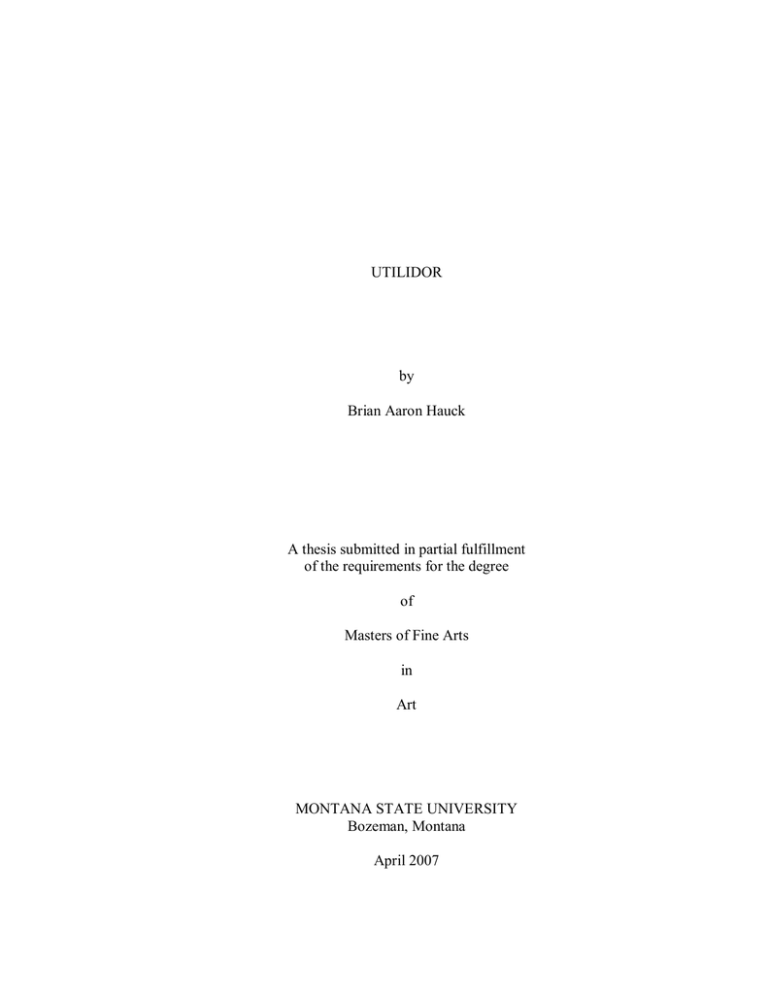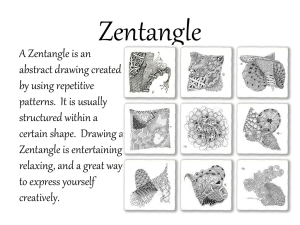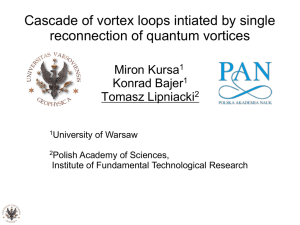
UTILIDOR by Brian Aaron Hauck A thesis submitted in partial fulfillment of the requirements for the degree of Masters of Fine Arts in
Art MONTANA STATE UNIVERSITY Bozeman, Montana April 2007
©COPYRIGHT By Brian Aaron Hauck 2007 All Rights Reserved
ii APPROVAL of a thesis submitted by Brian Aaron Hauck This thesis has been read by each member of the thesis committee and has been found to be satisfactory regarding content, English usage, format, citations, bibliographic style, and consistency, and is ready for submission to the Division of Graduate Education. Richard Helzer Chair Approved for the School of Art Richard Helzer Director Approved for the Division of Graduate Education Dr. Carl Fox Vice Provost
iii STATEMENT OF PERMISSION TO USE In presenting this thesis in partial fulfillment the requirements for a master’s degree at Montana State University, I agree that the Library shall make it available to borrowers under rules of the Library. If I have indicated my intention to copyright this thesis by including a copyright notice page, copying is allowable only for scholarly purposes, consistent with “fair use” as prescribed in the U.S. Copyright Law. Requests for permission for extended quotation from or reproduction of this thesis in whole or in parts may be granted only by the copyright holder. Brian Aaron Hauck April 19, 2007
iv LIST OF IMAGES Images Page 1. Gallery View..................................................................................................3 2. Gallery View..................................................................................................4 3. Gallery View with Artist ................................................................................5 4. Gallery View..................................................................................................6 5. Show Sign......................................................................................................7 6. Tension Tangle, 2007, 8’x8’, steel and hardwood...........................................8 7. Tension Tangle, Detail ...................................................................................9 8. Tension Tangle, Detail .................................................................................10 9. Flat­Bar Tangle, 2007, 9’x5’x4’, welded steel ..............................................11 10. Flat­Bar Tangle, Detail.................................................................................12 11. Cubic Tangle, 2007, 5’x5’x3’, steel and fir...................................................13 12. Cubic Tangle, Detail ....................................................................................14 13. Cubic Tangle, Detail ....................................................................................15 14. Buckled Plank Tangle, 2007, 3.5’x7’x4’, steel and pine................................16 15. Buckled Plank, Detail...................................................................................17 16. Buckled Plank, Detail...................................................................................18 17. Downspout Tangle, 2007, 8’x7’x7’, PVC plastic..........................................19 18. Downspout Tangle, Detail ............................................................................20 19. Rusted Tangle, 2006, 5’x8’x8’, steel ............................................................21 20. Rusted Tangle, from above...........................................................................22
1 A utilidor is a system of above­ground pipes or tubes used to carry electricity and water in regions with yearly permafrost. These networks are made up of a limited number of recurring elements that rely on one another to complete the needed task. My sculptures are complex entanglements that are constructed in a similar fashion and direct the eye as the utilidor directs electricity or water. I have always been intrigued by the way the physical structures are organized. Interstate highways, sports stadiums, roller coasters, scaffolding, plumbing pipes, and assembly plants are examples of complete or fragmented systems, or infrastructures, that I find conceptually and visually appealing. Growing up in a small and remote town in northeastern Oklahoma that was mostly devoid of these types of structures made them exotic to me. While traveling through major cities as a child, I keenly observed these grandiose architectural and industrial frameworks. As humans, we grapple with numerous systematized occurrences on a daily basis. Like the physical structures mentioned above, these occurrences are bound together and can inform one another. These experiences have had a lasting influence on my aesthetic and artistic message. Toys that mimic modern construction methods, such as Legos, Construxs, and Lincoln Logs were an essential part of my childhood and are visually accessible to most. These toys are made in such a way that the pieces can systematically fit together in any number of configurations and my current form of sculpture is no different. Inspired by toys, routines, architecture, and industry, I compose wood and steel components that methodically collaborate to create tense, linear masses.
2 I fabricate or utilize two primary types of segments in each sculpture. The first, a nexus, is generally a device that links a series of elements, and the second, a conduit is, a pipe or tube that transmits water or electricity, like a utilidor does. The “nexuses” and “conduits” are designed to be structurally and visually compatible. These components and the method of production generates a mechanical aesthetic that also refers to the way our daily activities are bound together to form one organized action. This body of work embodies my fascination with processes and materials that have been informed by ephemeral experiences within an urban world that was once very foreign to me because of a rural upbringing. While not being directly representative, the elements I present are akin to architectural and industrial forms. They provide the viewer with a familiar palette of information, or comfort zone, to understand the coordinated formation involved and become visually consumed with the number of parts present and the way the parts react with and rely on one another within the gallery space.
3 1. Gallery View
4 2. Gallery View
5 3. Gallery View with Artist
6 4. Gallery View
7 5. Show Sign
8 6. Tension Tangle, 2007, 8’x8’, steel and hardwood
9 7. Tension Tangle, 2007, 8’x8’, steel and hardwood
10 8. Tension Tangle, 2007, 8’x8’, steel and hardwood
11 9. Flat­Bar Tangle, 2007, 9’x5’x4’, welded steel
12 10. Flat­Bar Tangle, 2007, 9’x5’x4’, welded steel
13 11. Cubic Tangle, 2007, 5’x5’x3’, steel and fir
14 12. Cubic Tangle, 2007, 5’x5’x3’, steel and fir
15 13. Cubic Tangle, 2007, 5’x5’x3’, steel and fir
16 14. Buckled Plank Tangle, 2007, 3.5’x7’x4’, steel and pine
17 15. Buckled Plank Tangle, 2007, 3.5’x7’x4’, steel and pine
18 16. Buckled Plank Tangle, 2007, 3.5’x7’x4’, steel and pine
19 17. Downspout Tangle, 2007, 8’x7’x7’, PVC plastic
20 18. Downspout Tangle, 2007, 8’x7’x7’, PVC plastic
21 19. Rusted Tangle, 2006, 5’x8’x8’, steel
22 20. Rusted Tangle, 2006, 5’x8’x8’, steel


